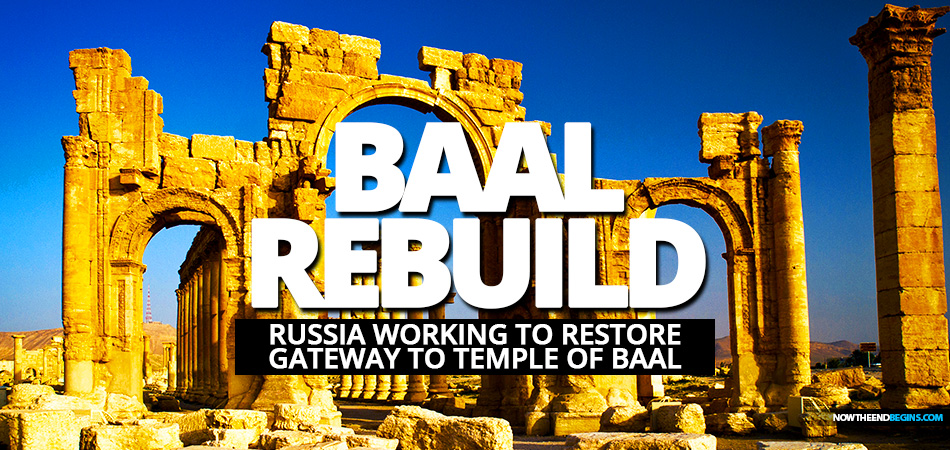
After six years of laying in ruin, the Russians have begun reconstructing the Triumphal Arch of Palmyra in Syria that served as a gateway to a major pagan temple to Baal. Rebuilding the arch is predicted in the Talmud as preceding the Messiah.
Just last month, Pope Francis was in Ur of the Chaldees, taking a Chrislam victory lap in the birthplace of Abraham, and today we are hearing news that Russia is helping Syria to restore the Arch of Palmyra that served the ancient world as a gateway to the Temple of Baal. This is how close we are to the Pretribulation Rapture of the Church.
"And he did that which was evil in the sight of the LORD, after the abominations of the heathen, whom the LORD cast out before the children of Israel. For he built up again the high places which Hezekiah his father had destroyed; and he reared up altars for Baal, and made a grove, as did Ahab king of Israel; and worshipped all the host of heaven, and served them." 2 Kings 21:2,3 (KJB)
Since the signing of the Abraham Accords, the Middle East has become a very different place, so different in fact that we are watching the entire region preparing itself to receive Antichrist. What could be more fitting than having 2 of the key players mentioned in Ezekiel 39 working on rebuilding the Arch of Palmyra, the gateway to the Temple of Baal? Very soon the man of sin will reveal himself, and you and I who are saved will fly on Flight #777.
Is This Preparation For The Arrival Of Antichrist?
ISRAEL 365 NEWS: The ruins of the ancient city of Palmyra located about 135 miles north of Damascus were a huge tourist attraction, drawing 105,000 visitors a year until the devastating civil war broke out in Syria in 2011. The temple and much of the site were destroyed by the Islamic State (ISIS) in 2015. The Monumental Arch, a centerpiece of the site that was mostly destroyed, was built during the reign of Roman Emperor Septimius Severus in about 200 CE. It is estimated that only 30-40% of the stones in the arch remain.
Nazir Awad, director-general of the Syrian Antiquities and Museums Directorate, explained to Al-Ahed News that “meetings have taken place with Russian experts to discuss the work that will begin to restore and resurrect the Arch of Triumph. They are in the process of documenting and studying in order to outline the restoration work.”
“The necessary programs have been put in place to establish working groups concerned with documentation and preparation of documents as part of the restoration work and other teams to handle the rubble,” he added.
Awad points out that “the work did not actually start, but a working paper was drawn up from the Syrian side, with specific tasks prepared for teams, as this type of work follows global standards. The coronavirus is affecting the progress of the restoration work with the Association Stone Industry of Russia, and the Directorate is in contact with UNESCO and other institutions.”
“The Syrian experts have put in place some plans, and there is no precise timetable for the completion of the work, but studies on restoration, rubble, and so on may be ready within six or eight months.”
The executive director of the Palmyra Restoration Fund, Sergei Tiglinov, said that specialists will make a 3D scan of all the elements, translate them into a virtual model, and then put them together in the restored monument.
Restoration work began this week after a memorandum of understanding was reached between the Syrian Ministry of Culture and the Association Stone Industry of Russia. In 2019, the State Hermitage Museum in Saint Petersburg announced plans to restore the site in conjunction with the Institute of the History of Material Culture of the Russian Academy of Sciences and Syria’s Directorate General of Antiquities and Museums (DGAM). The project will also be under the auspices of the United Nations Educational, Scientific and Cultural Organization (UNESCO).
The site, once a vital point on the Silk Road caravan route, has artifacts dating back to the Neolithic period. The Temple of Palmyra was dedicated in 32 CE to the worship of Ba’al. The earliest known inhabitants were the Amorites in the early second millennium BCE. As such, it hosted many monumental projects including the Temple of Bel (or Ba’al). The temple was built on the site of a prior pagan temple dating back to the third millennium BCE. The most recent of the temples were dedicated in 32 CE. Converted into a Christian church during the Byzantine Era, parts of the structure were modified into a mosque by Muslims in 1132. It remained in use as a mosque until the 1920s.
The arch stood at the entrance to the temple used to worship Bel, also known as Ba’al. Mentioned more than 90 times in the Bible, most notably when Elijah defeated the priests of Ba’al, also known as Moloch, in a contest to bring down fire from heaven to burn a sacrifice, Ba’al became the archetypical form of idol worship. Pantheistic, his adherents worshipped Mother Nature while denying the existence of a creator. Followers of Ba’al engaged in bisexual orgies and sacrificed human infants, burning them alive. Anthropologists conjecture that the child sacrifice was to cull the population after the inevitable outcome of wanton sexuality. READ MORE
No comments:
Post a Comment